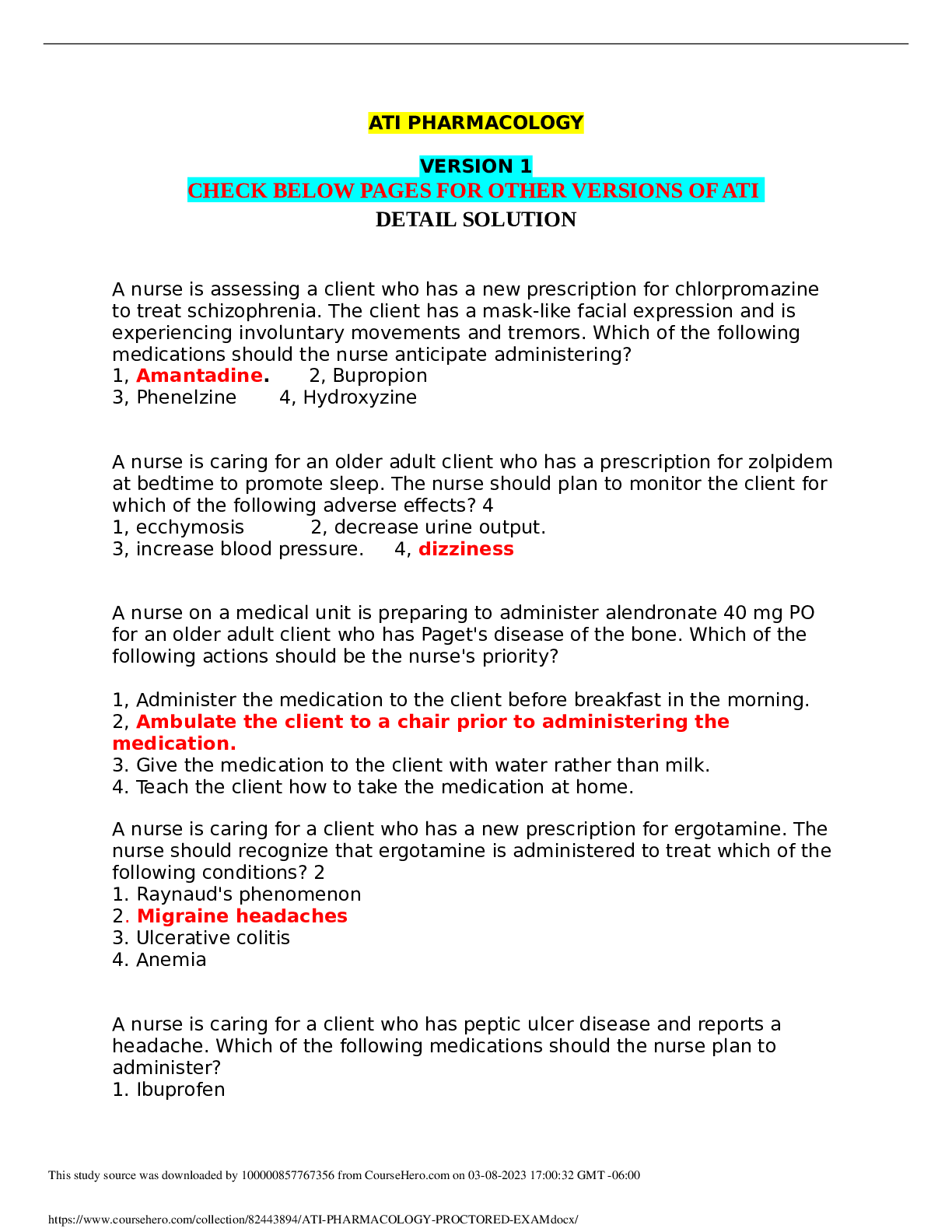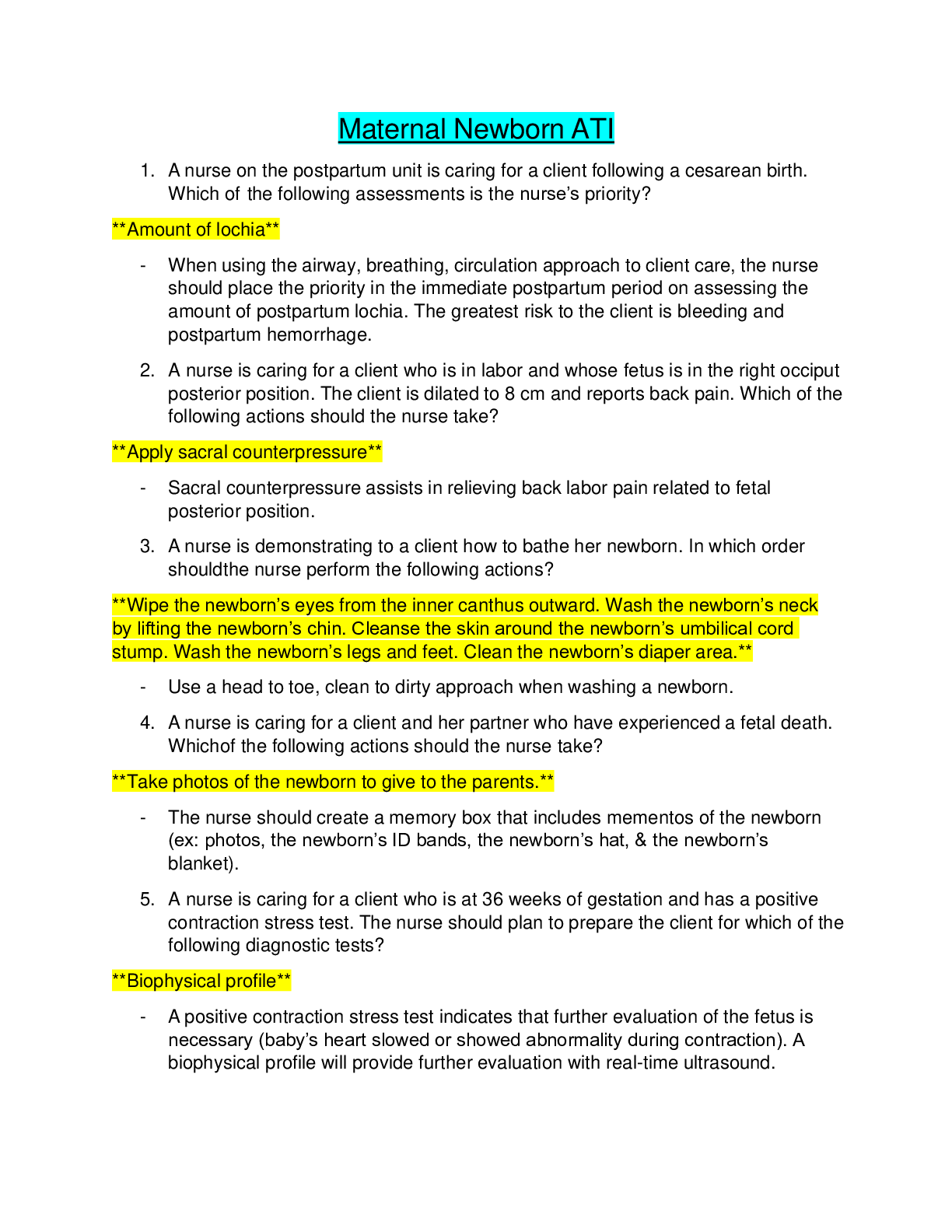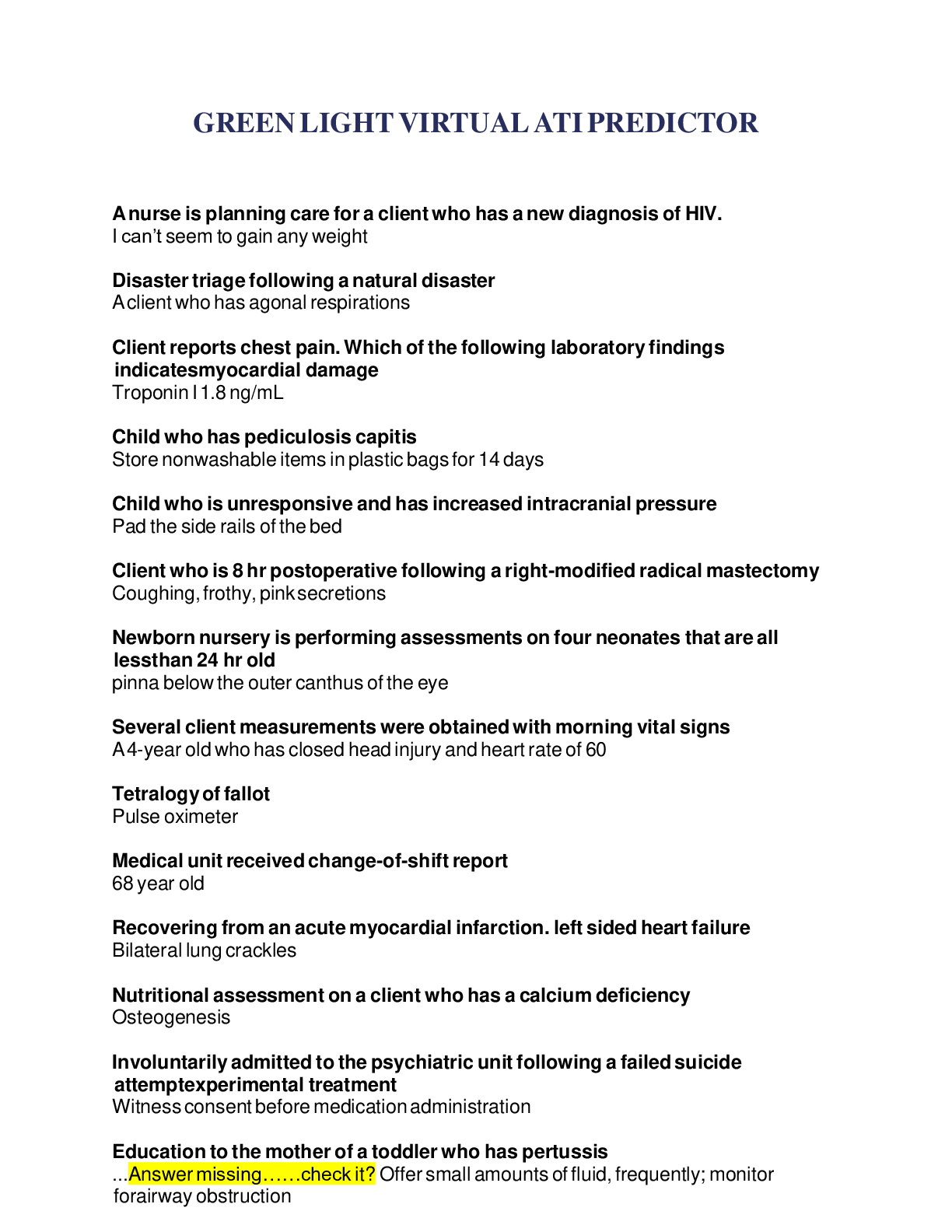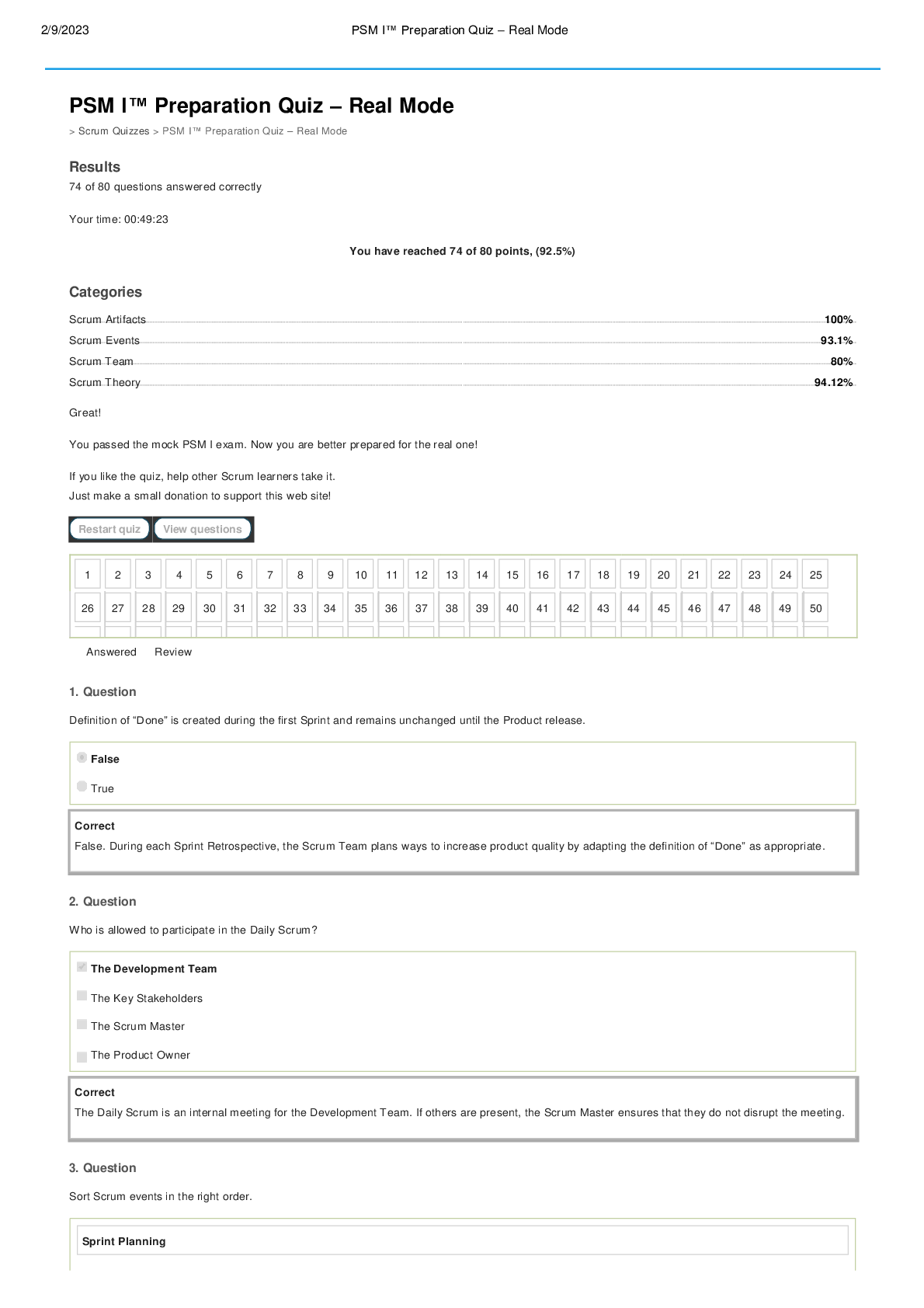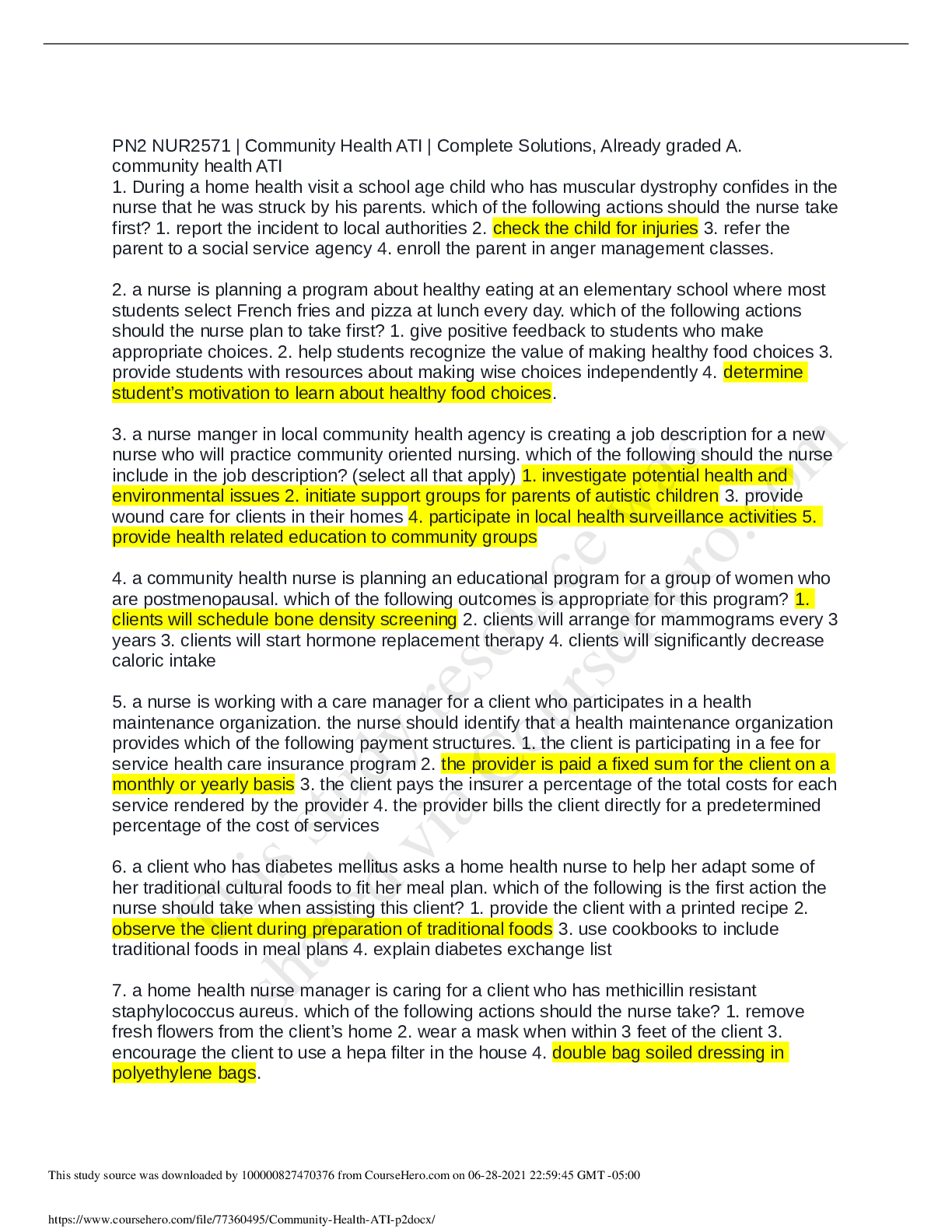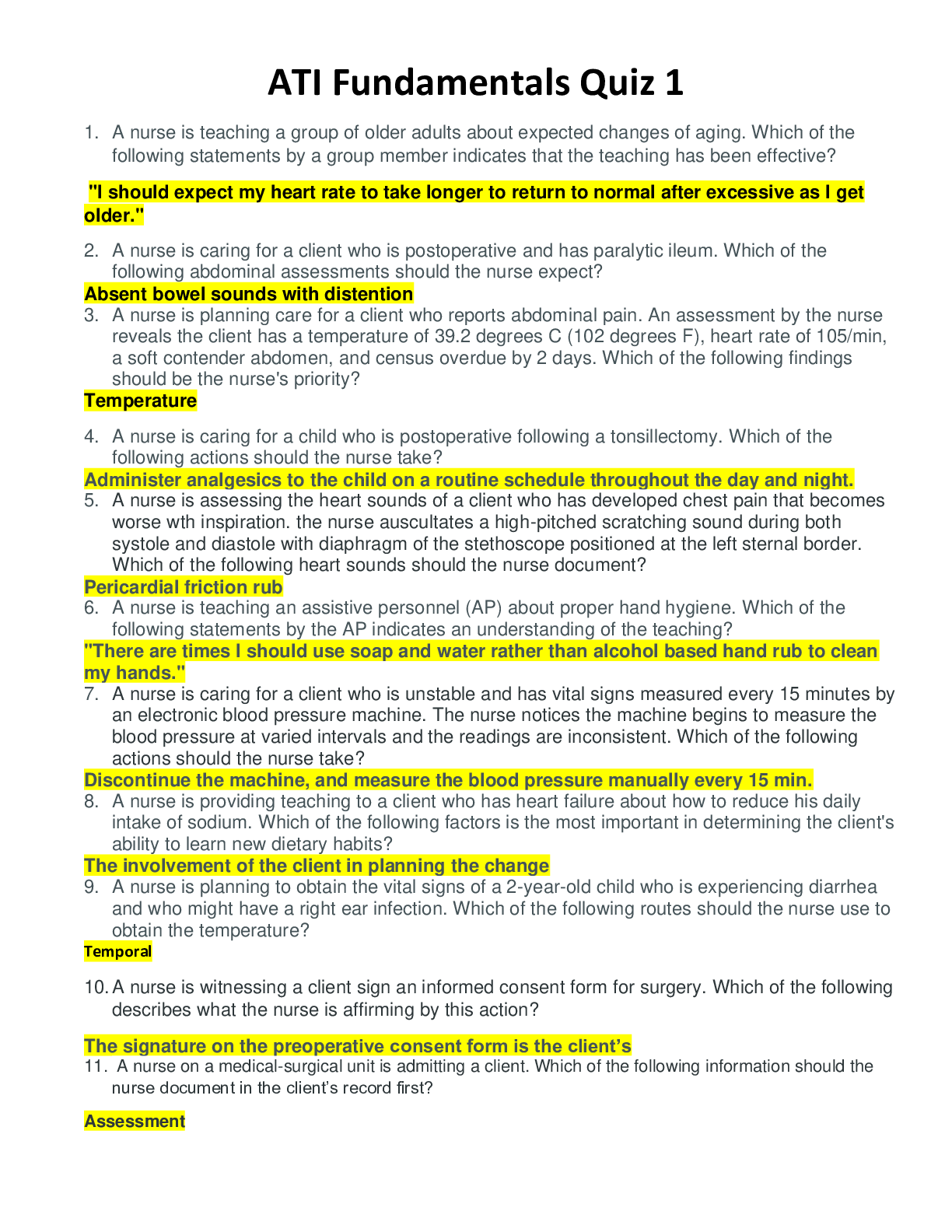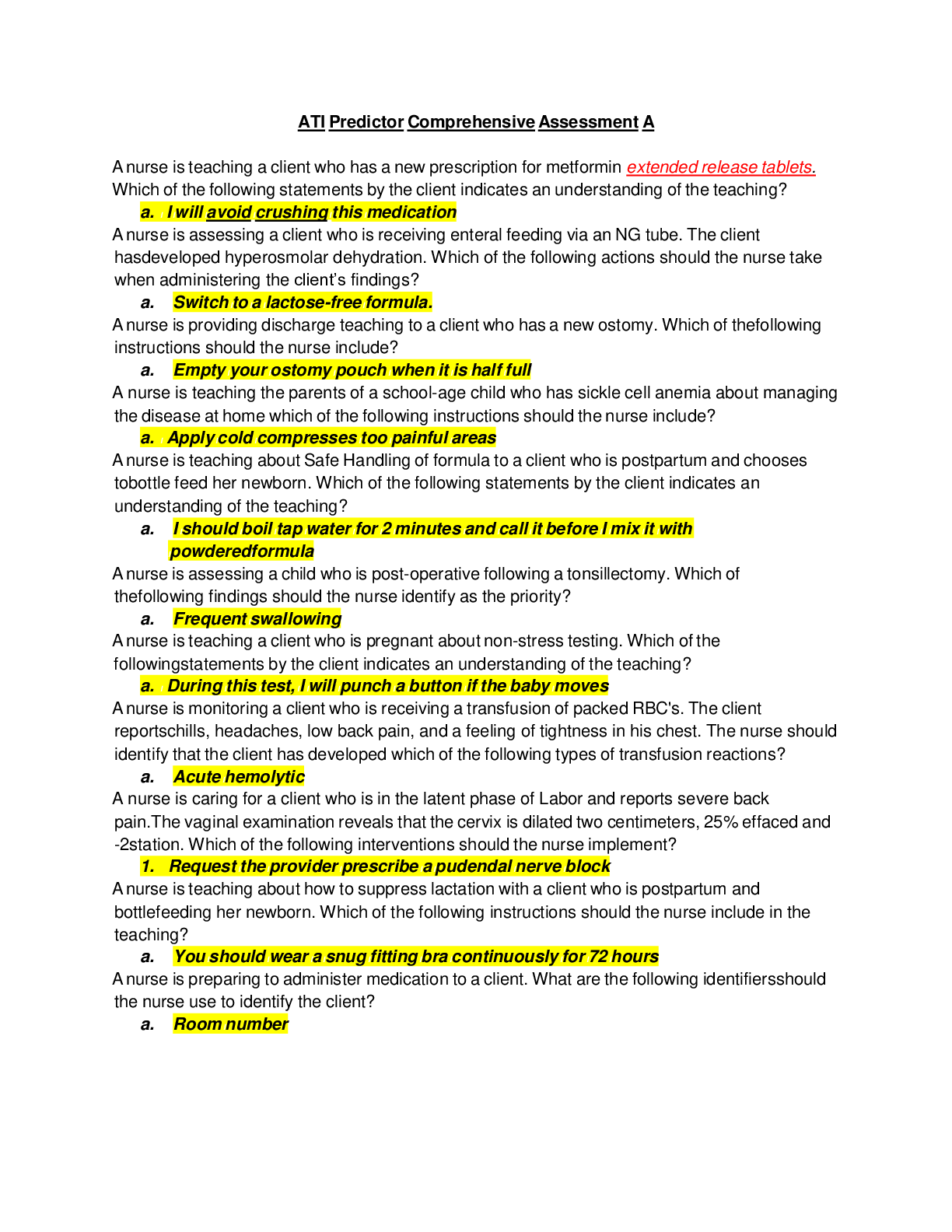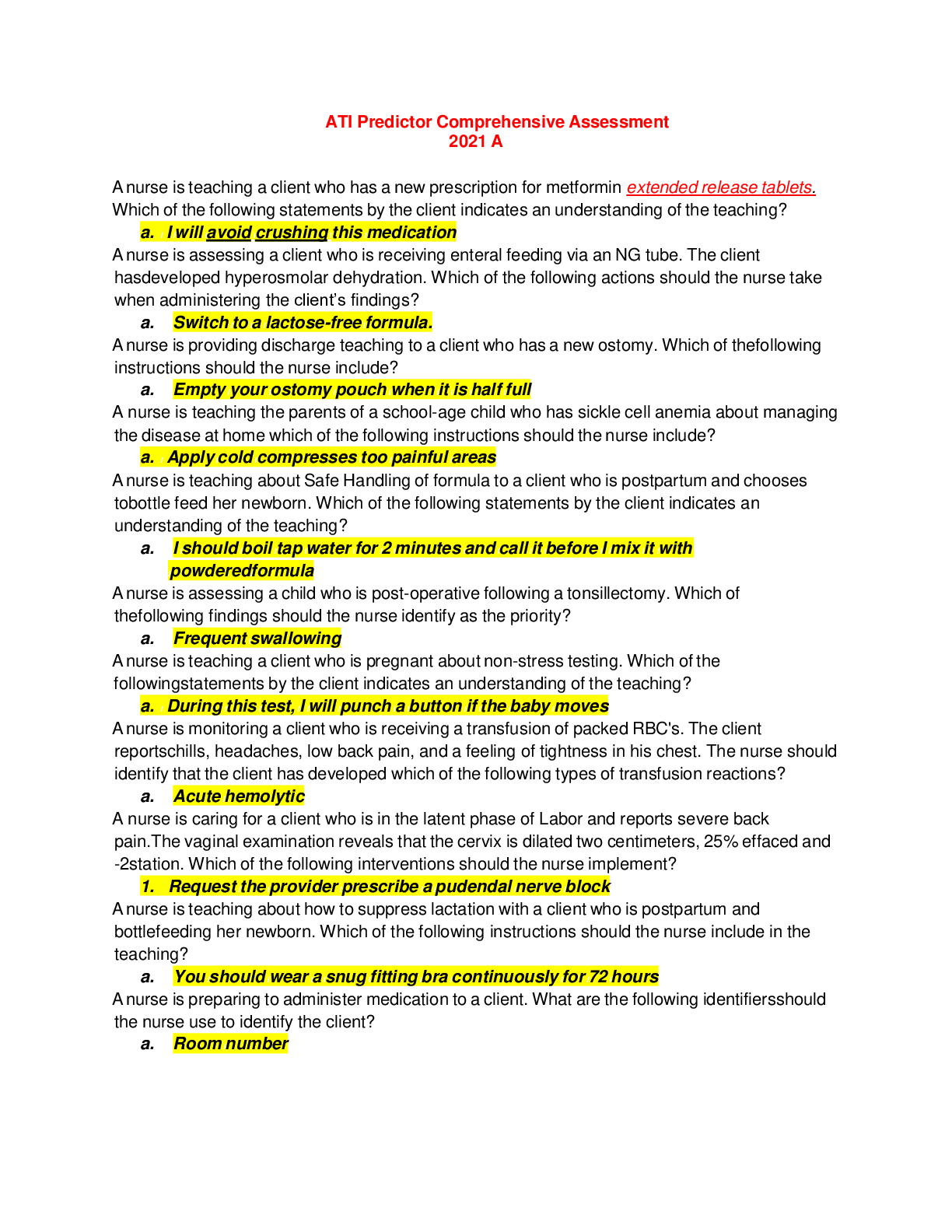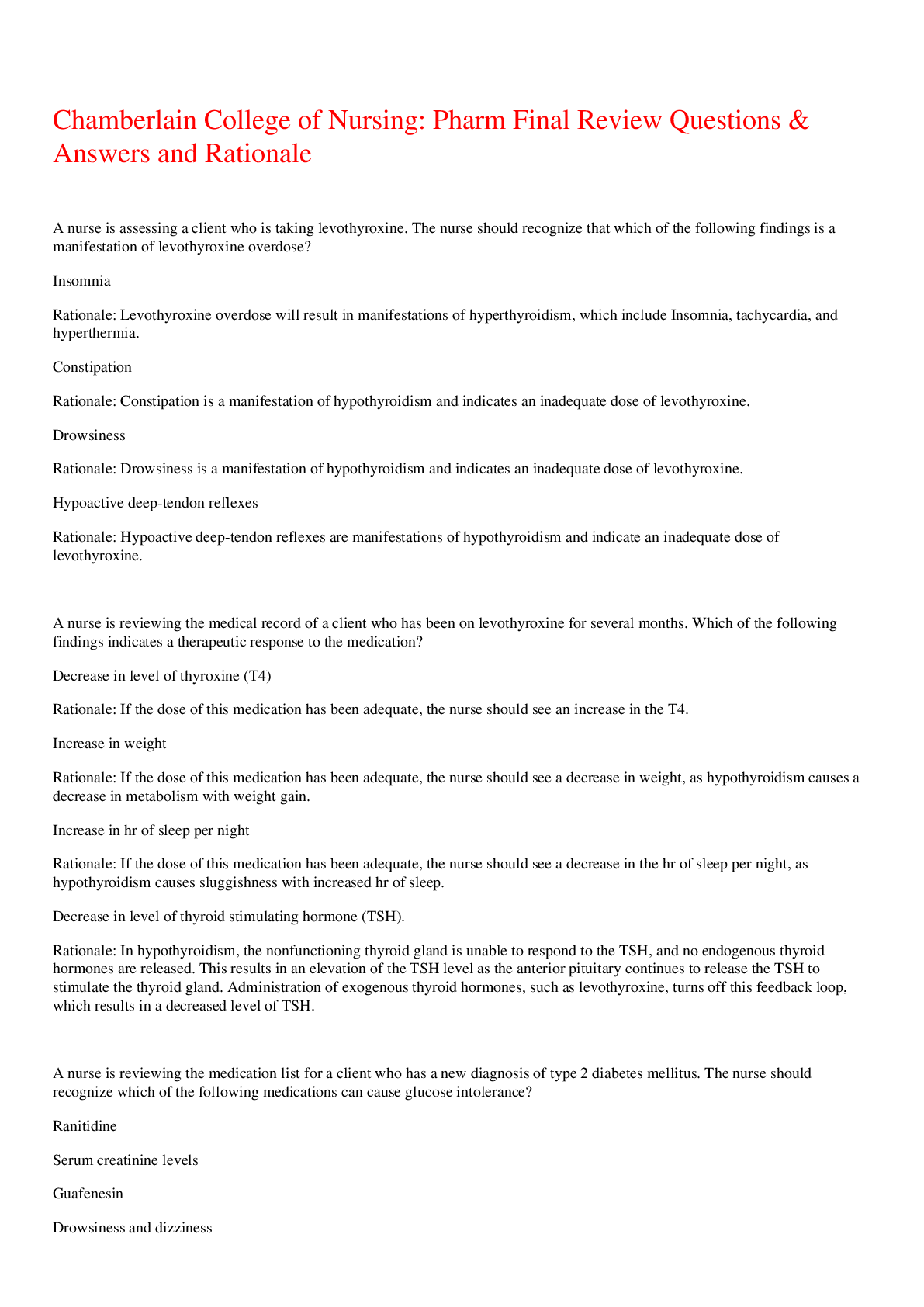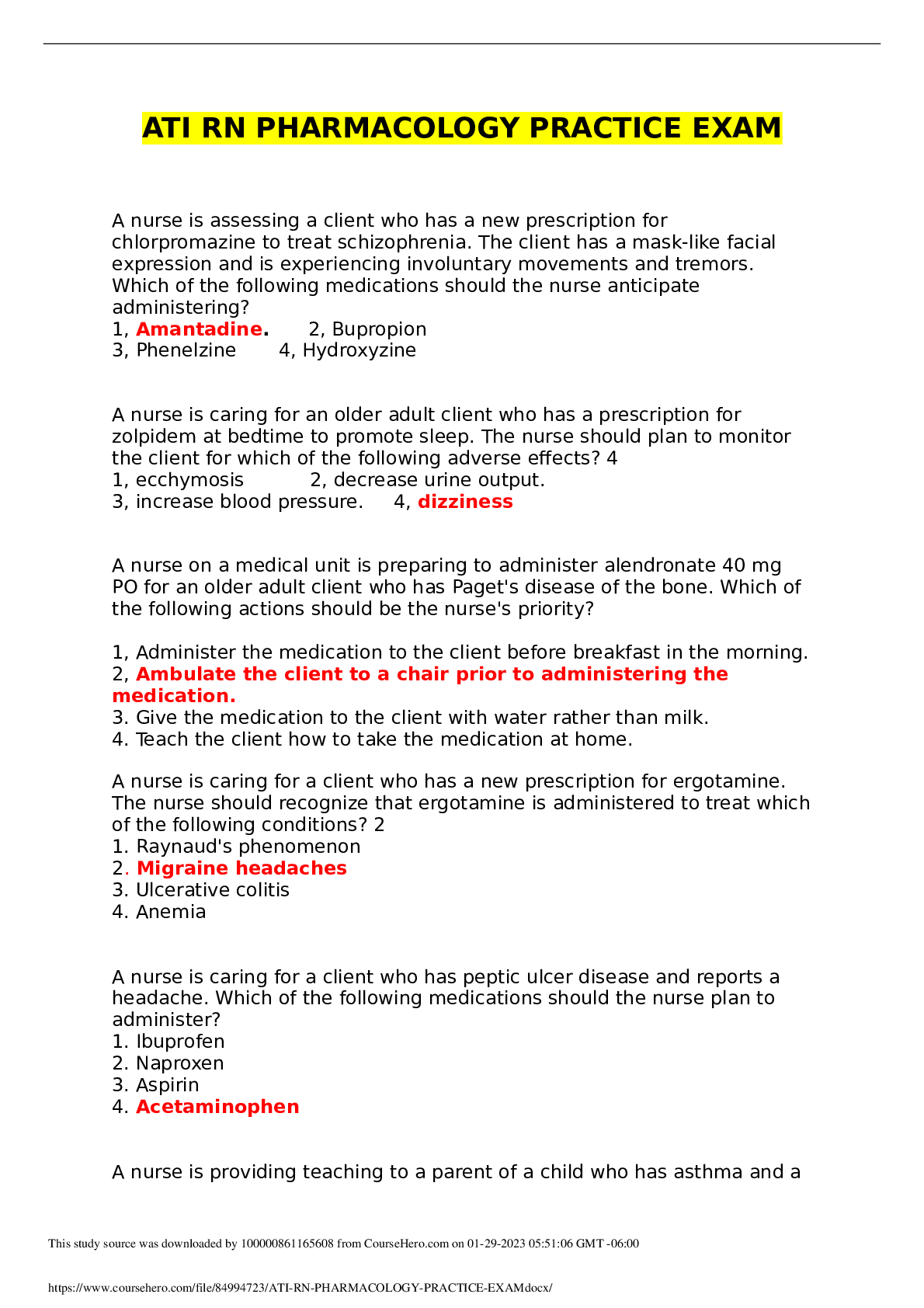*NURSING > QUESTIONS and ANSWERS > Peds ATI Practice A | DETAILED SOLUTIONS | Already Graded A (All)
Peds ATI Practice A | DETAILED SOLUTIONS | Already Graded A
Document Content and Description Below
Peds ATI Practice A 1. A nurse is assessing the vital signs of a 10-year-old child following a burn injury. Clinical manifestation that indicate early septic shock? Temperature 39.1C (102.4F)- The n... urse should identify that a temperature of 39.1° C (102.4° F) is above the expected reference range of 37° to 37.5° C (98.6° to 99.5° F) for a 10-year-old child. The nurse should expect a child who has early septic shock to have a fever and chills. 2. Assessing a school-age child immediately postop following a perforated appendix repair. Expected findings? Absence of peristalsis- The nurse should expect absence of peristalsis immediately following a perforated appendix repair, until the bowel resumes functioning. Purulent drainage is not an expected finding following a perforated appendix repair. The nurse should expect brown to green-tinged drainage from the NG tube. Passage of dark red stool with mucus is not an expected finding immediately following a perforated appendix repair. The nurse should identify this finding as a manifestation of Meckel diverticulum The nurse should expect a WBC count greater than 20,000/mm3 in a client who has had a ruptured appendix. 3. A nurse is caring for a school-age child who is receiving chemotherapy and is severely immunocompromised. Which of the following actions should the nurse take? Screen the child's visitors for indications of infection.- A child who is severely immunocompromised is unable to adequately respond to infectious organisms, resulting in the potential for overwhelming infection. Therefore, the nurse should screen the child's visitors for indications of infection. It is not necessary for the nurse to use surgical asepsis when providing direct care. Strict hand hygiene and medical asepsis are recommended to prevent the spread of infection. The MMR vaccine is contraindicated for a child who is severely immunocompromised because it is a live virus vaccine and the child might not be able to build adequate antibodies to prevent infection with the organism 4. 1 capsule 5. A nurse is reviewing the laboratory report of a 7 year-old child who is receiving chemotherapy. Which of the following lab values should the nurse report to the provider? Hgb 8.5 g/dL- A child receiving chemotherapy is at risk for anemia due to the chemotherapy effects on the blood-forming cells of the bone marrow. The development of anemia is diagnosed through laboratory testing of hemoglobin and hematocrit levels. The nurse should recognize that a hemoglobin level of 8.5 g/dL is below the expected reference range of 10 to 15.5 g/dL for a 7-year-old child and should be reported to the provider A child receiving chemotherapy is at risk for malnutrition as a result of nausea and vomiting, stomatitis, and pain. Nutritional status can be evaluated through prealbumin, albumin, and transferrin levels. A prealbumin level of 18 mg/dL is within the expected reference range of 15 to 33 mg/dL for a 7-year-old child. A child receiving chemotherapy is at risk for hemorrhage due to the thrombocytopenic effects of the medications used to treat cancer. The development of thrombocytopenia is diagnosed through laboratory testing of platelet levels. A platelet count of 300,000/mm3 is within the expected reference range of 150,000 to 400,000/mm3 for a 7-year-old child. 6. A nurse is caring for a 15 year-old client who is married and is scheduled for a surgical procedure. The client asks, "who should sign my surgical consent?" Which of the following responses should the nurse make? "You can sign the consent form because you are married.- "The nurse should inform the adolescent that marriage gives adolescents the legal right to consent to surgical procedures and sign other legal documents that they would not otherwise be able to sign due to their age. 7. A nurse is teaching the parents of a school-age child who has a new diagnosis of osteomyelitis of the tibia. The nurse should identify that which of the following statements by the parents indicates an understanding of the teaching? my child will receive antibiotics for several weeks- The nurse should instruct the parent that the child will receive antibiotic therapy for at least 4 weeks. Surgery might be indicated if the antibiotics are not successful. Bearing weight must be avoided with osteomyelitis. Therefore, the child should be placed in a comfortable position with the limb supported. There is no indication for a cast. 8. A nurse is teaching a school-age child who has a new diagnosis of type 1 diabetes mellitus. Which of the following statements by the child indicates an understanding of the teaching? "I will give myself a shot of regular insulin 30 minutes before I eat breakfast. -"The child should administer regular insulin 30 min before meals so that the onset coincides with food intake. The child should avoid puncturing the pads of the fingers because they have fewer blood vessels and more nerve fibers. Instead, the child should puncture the skin on either side of the finger pad to promote blood flow and decrease pain. 9. A nurse is caring for a school-age child who is receiving cefazolin via intermittent IV bolus. The child suddenly develops diffuse flushing of the skin and angioedema. After discontinuing the medication infusion, which of the following medications should the nurse administer first? Epinephrine- This child is most likely experiencing an anaphylactic reaction to the cefazolin. According to evidence-based practice, the nurse should first administer epinephrine to treat the anaphylaxis. Epinephrine is a beta adrenergic agonist that stimulates the heart, causes vasoconstriction of blood vessels in the skin and mucous membranes, and triggers bronchodilation in the lungs. 10. A nurse is auscultating the lungs of an adolescent who has asthma. The nurse should identify the sound as which of the following? Tachypnea- The nurse should identify the sound heard during auscultation as tachypnea, which is a rapid, regular breathing pattern. This breathing pattern often occurs with anxiety, fever, metabolic acidosis, or severe anemia. The nurse should identify Biot respirations as periods of apnea alternating with breaths of increased but consistent depth. The nurse should identify Cheyne-Stokes respirations as periods of apnea alternating with periods of hyperventilation. 11. A nurse in an urgent care clinic is assessing an adolescent who has an upper respiratory tract infection. Which of the following findings should the nurse identify as a manifestation of pertussis? dry, hacking cough- The nurse should identify that a dry, hacking cough is a manifestation of pertussis. This disease usually begins with indications of an upper respiratory tract infection, which includes a dry, hacking cough that is sometimes more severe at night. The nurse should identify that an inflamed throat with exudate is a manifestation of acute streptococcal pharyngitis. The nurse should identify that Koplik spots on buccal mucosa are a manifestation of rubeola, or measles 12. A nurse is caring for a toddler who has spastic (pyramidal) cerebral palsy. Which of the following findings should the nurse expect? (Select all that apply.) -Ankle clonus-Exaggerated stretch reflexes-Contractures- Negative Babinski reflex is incorrect. The nurse should expect a child who has spastic cerebral palsy to exhibit a positive Babinski reflex. Ankle clonus is correct. The nurse should expect a child who has spastic cerebral palsy to exhibit ankle clonus, which is a rhythmic reflex tremor when the foot is dorsiflexed. Exaggerated stretch reflexes is correct. The nurse should expect a child who has spastic cerebral palsy to exhibit spasticity or exaggerated stretch reflexes. Uncontrollable movements of the face is incorrect. The nurse should expect a child who has nonspastic (dyskinetic) cerebral palsy, rather than spastic (pyramidal) cerebral palsy to exhibit uncontrollable movements of the face and extremities. Contractures is correct. The nurse should expect a child who has spastic cerebral palsy to exhibit contractures due to the tightening of the muscles. 13. A nurse in an emergency department is performing an admission assessment on a 2 week-old male newborn. Which of the following findings is the priority for the nurse to report to the provider? substernal retractions- When using the airway, breathing, and circulation approach to client care, the nurse should determine that the priority finding to report to the provider is substernal retractions. This finding indicates the newborn is experiencing increased respiratory effort, which could quickly progress to respiratory failure. 14. A nurse is caring for an adolescent who received a kidney transplant. Which of the following findings should the nurse identify as an indication the adolescent is rejecting the kidney? Serum creatinine 3.0 mg/dL- Creatinine is a byproduct of protein metabolism and is excreted from the body through the kidneys. An elevated serum creatinine level, therefore, can be an indication that the kidneys are not functioning. The nurse should identify that the adolescent's serum creatinine level is higher than the expected reference range of 0.4 to 1.0 mg/dL for an adolescent and can indicate rejection of the kidney. The nurse should identify that a negative leukocyte esterase level is an expected finding and indicates that the adolescent does not have a urinary tract infection. A negative leukocyte esterase does not indicate rejection of the kidney. 15. A nurse is assessing a toddler who has gastroenteritis and is exhibiting manifestations of dehydration. Which of the following findings is the nurses priority? Tachypnea- When using the airway, breathing, and circulation approach to client care, the nurse's priority finding is the toddler's tachypnea. Tachypnea is a result of the kidneys being unable to excrete hydrogen ions and produce bicarbonate, which leads to metabolic acidosis. 16. A nurse is creating a plan of care for an infant who has an epidural hematoma from a head injury. Which of the following interventions should the nurse include in the plan? Implement seizure precautions for the infant.-An infant who has an epidural hematoma is at great risk for seizure activity. Therefore, the nurse should implement seizure precautions for the child. The nurse should avoid suctioning the infant's nares due to the risk of exposure of the suction catheter to the brain through the fracture; however, oral suctioning can be performed. The nurse should perform a neurological assessment as frequently as every 15 min to detect changes in the child's condition and monitor for intracranial pressure. The nurse should position the infant with their head slightly elevated in a midline position to reduce the risk of increased intracranial pressure. 17. A nurse is teaching the parent of an infant who has a Pavlik harness for the treatment of developmental dysplasia of the hip. The nurse should identify that which of the following statements by the parent indicates an understanding of the teaching? place diapers under the harness straps- To prevent soiling of the harness, the parent should apply the infant's diaper under the straps The use of powders and lotions should be avoided during treatment with a Pavlik harness because these products, in combination with the harness, can cause skin irritation and breakdown The Pavlik harness is designed to maintain the infant's hips in a position of flexion and abduction. The nurse should instruct the parent not to adjust the harness in any way to avoid complications. The harness is to be worn continuously until the hip is stable, which usually occurs within 6 to 12 weeks. Removing the harness frequently or for long periods of time will reduce the effectiveness of the treatment. 18. A nurse is caring for a toddler who is experiencing acute diarrhea and has moderate dehydration. Which of the following nutritional items should the nurse offer to the toddler? Oral rehydration solution- A toddler who has acute diarrhea should consume an oral rehydration solution to replace electrolytes and water by promoting the reabsorption of water and sodium. This promotes recovery from dehydration. A toddler who has acute diarrhea should not eat peanut butter because it is high in carbohydrates and fiber. The high sugar content can result in prolonging the diarrhea and worsening of the dehydration, because water is pulled into the bowel lumen in response to the increased osmolality caused by the sugar. The fiber content further stimulates the bowel, worsening the diarrhea. A toddler who has acute diarrhea should not drink apple juice because it is high in carbohydrates and osmolarity and low in electrolytes 19. A nurse is admitting a school-age child who has Pertussis. Which of the following actions should the nurse take? initiate droplet precautions- The nurse should initiate droplet precautions for a child who has pertussis, also known as whooping cough. Pertussis is transmitted through contact with infected large-droplet nuclei that are suspended in the air when the child coughs, sneezes, or talks. The nurse should place a child who has undergone an allogeneic hematopoietic stem cell transplant in a room with positive-pressure airflow to reduce the risk of disease transmission to the child. The nurse should place a child who has an airborne infection, such as measles or varicella, into a room with negative-pressure airflow. The nurse should initiate contact precautions for a child who has an illness that can be transmitted by direct contact or contact with the child's items, such as hepatitis A and rotavirus. 20. A charge nurse in an emergency department is preparing an in-service for a group of newly licensed nurses on the clinical manifestations of child maltreatment. Which of the following manifestations should the charge nurse include as suggestive of potential physical abuse? symmetric burns of the lower extremities- The nurse should include that symmetric burns to the lower extremities can indicate physical abuse. The patterns are usually characteristic of the method or object used, such as cigar or cigarette burns, or burns in the shape of an iron. Failure to thrive can be an indication of physical neglect due to malnutrition. Lack of subcutaneous fat can be an indication of physical neglect. This manifestation can be a result of poor health care, infections that were untreated, and/or a lack of or delayed childhood immunizations. Recurrent urinary tract infections are a clinical manifestation that can indicate sexual abuse. 21. A nurse is caring for a school-age child who in in Buck's traction following a leg fracture 24 hr ago. Which of the following actions should the nurse take? Assess peripheral pulses once every 4 hr.- Buck's traction is a type of skin traction that can be used to immobilize extremities prior to surgery. The nurse should provide frequent neurovascular checks at least every 4 hr after the first 24 hr of placement in Buck's traction. The nurse should monitor and report signs of neurovascular impairment in the extremities such as cyanosis, edema, pain, absent pulses, and tingling. The nurse should maintain the child in a supine position while in Buck's traction. Elevating the head of bed should be implemented for a child who is in cervical traction. Buck's traction is a type of skin traction that can be used to immobilize extremities prior to surgery and does not involve the use of pins. A child who requires skeletal traction will require pin site care. 22. A nurse is planning care for a toddler who has a serum lead level of 4 mcg/dL. Which of the following actions should the nurse plan to take? Schedule the toddler for a yearly rescreening.- The nurse should schedule the toddler for a lead level rescreening in 1 year and educate the family on ways to prevent exposure. The nurse should instruct the toddler's parents to provide a diet rich in calcium because calcium, vitamin C, and iron decrease lead absorption. Chelation therapy is required for a lead level of 45 mcg/dL or greater and, depending on the situation, can be initiated for lead levels over 10 mcg/dL. A serum lead level of 4 mcg/dL does not require a report to Child Protective Services because it is not an indicator of child endangerment. 23. A school nurse is assessing an adolescent who has multiple burns in various stages of healing. Which of the following behaviors should the nurse identify as a possible indication of physical abuse? denies discomfort during assessment of injuries- The nurse should suspect child maltreatment in the form of physical abuse if the adolescent has a blunted response to painful stimuli or injury. 24. The nurse is providing discharge teaching to the parent of a child who is 1 week postoperative following a cleft palate repair. For which of the following members of the inter professional team should the nurse initiate a referral? speech therapist- The nurse should initiate a referral for a speech therapist for a child who is postoperative following a cleft palate repair. A child who has a cleft palate will require speech therapy immediately following the repair to support speech development and future articulation. The nurse should initiate a referral for an occupational therapist for a child who has physical disabilities and requires assistance with ADLs. 25. A nurse is teaching the parent of an infant about ways to prevent sudden infant death syndrome (SIDS). Which of the following instructions should the nurse include? give the infant a pacifier- The nurse should inform the parent that protective factors against SIDS include breastfeeding and the use of a pacifier when the infant is sleeping. 26. A nurse is caring for a school-age child who has experienced a tonic-clonic seizure. Which of the following actions should the nurse take during the immediate postictal period? place child in side-lying position- The nurse should place the child in a side-lying position to prevent aspiration. 27. A hospice nurse is caring for a preschooler who has a terminal illness. The father tells the nurse that he cannot cope anymore and has decided to move out of the house. Which of the following statements should the nurse make? "Let's talk about some of the ways you have handled previous stressors in your life."- This statement offers a general lead to allow the parent to express their feelings and previous actions when faced with stressful situations. It also helps the parent to focus on ways that they can cope with the current situation. 28. A nurse in an emergency department is caring for a school-age child who is experiencing an anaphylactic reaction. Which of the following is the priority action by the nurse? administer epinephrine IM to the child- When using the urgent vs. nonurgent approach to client care, the nurse should determine that the priority action is administering epinephrine IM to the child. During an anaphylactic reaction, histamine release causes bronchoconstriction and vasodilation. This is an emergency because ultimately this causes decreased blood return to the heart. 29. A nurse in the emergency department is caring for a toddler who has a partial thickness burns on their right arm. Which of the following actions should the nurse take? cleanse with mild soap and water- The nurse should wash the affected area with mild soap and water to remove any loose tissue that could cause infection. The nurse should be aware that antibiotics are not routinely administered for the prevention of infection at the burn site because the decreased circulation in the burned area decreases the distribution of the medication to the deeper tissues. The nurse should apply an antimicrobial ointment to the affected area to prevent infection. The nurse should be aware that inserting a nasogastric tube to empty the contents of the stomach and maintain decompression is an intervention for major burn management. 30. The nurse is assessing a school-age child who has peritonitis. Which of the following findings should the nurse expect? Abdominal distention- The nurse should identify that abdominal distention is an expected finding of peritonitis. Peritonitis is an inflammation of the lining of the abdominal wall. This inflammation in the abdomen, along with the ileus that develops, causes abdominal distention. Other manifestations include chills, irritability, and restlessness. Hypoactive bowel sounds are a manifestation of peritonitis. The peritoneal inflammation caused by the feces and bacteria released from the perforated appendix results in the development of an ileus and a decrease in bowel motility. Tachycardia is a manifestation of peritonitis, resulting from infection and fluid shifts within the abdomen, which causes hypovolemia. Bloody stool is a manifestation of Meckel diverticulum, not peritonitis. Diarrhea or constipation can be manifestations of appendicitis. 31. A nurse is assessing a 3-year-old toddler at a well-child visit. Which of the following manifestations should the nurse report to the provider? Respiratory rate 45/min- The nurse should identify that a respiratory rate of 45/min is above the expected reference range of 20 to 25/min for a 3-year-old toddler and can indicate respiratory dysfunction and acute respiratory distress. Therefore, the nurse should report this finding to the provider. 32. A nurse is caring for a preschooler whose father is going home for a few hours while another relative stays with the child. Which of the following statements should the nurse make to explain to the child when their father will return? your daddy will be back after you eat- Preschoolers make sense of time best when they can associate it with an expected daily routine, such as meals and bedtime. Therefore, the child comprehends time best when it is explained to them in relation to an event they are familiar with, such as eating. 33. A nurse is reviewing the laboratory report of an infant who is receiving treatment for severe dehydration. The nurse should identify that which of the following laboratory values indicates effectiveness of the current treatment? Sodium 140 mEq/L- The nurse should identify that a sodium level of 140 mEq/L is within the expected reference range of 134 to 150 mEq/L and indicates the current treatment regimen the infant is receiving for dehydration is effective. 34. A nurse is teaching the parent of a preschooler about ways to prevent acute asthma attacks. Which of the following statements by the parent indicates an understanding of the teaching? "I should keep my child indoors when I mow the yard. -"The nurse should instruct the parent to keep the preschooler indoors during lawn maintenance or when the pollen count is increased. Guarding against exposure to known allergens found outdoors, such as grass, tree, and weed pollen, will decrease the frequency of the preschooler's asthma attacks. 35. A nurse is providing teaching to the parent of an infant who has diaper dermatitis. The nurse should instruct the parent to apply which of the following to the affected area? zinc oxide- Diaper dermatitis is a common inflammatory skin disorder caused by contact with an irritant such as urine, feces, soap, or friction, and takes the form of scaling, blisters, or papules with erythema. Providing a protective barrier, such as zinc oxide, against the irritants allows the skin to heal. 36. A nurse is planning care for a school-age child who is in the oliguric phase of acute kidney injury (AKI) and has a sodium level of 129 mEq/L. Which of the following interventions should the nurse include in the plan? Initiate seizure precautions for the child.- A sodium level of 129 mEq/L indicates hyponatremia and places the child at increased risk for neurological deficits and seizure activity. The nurse should complete a neurologic assessment and implement seizure precautions to maintain the child's safety. In the oliguric phase of AKI, the child will have decreased urine output and fluid retention. This can result in water intoxication, which predisposes the child to neurologic alterations such as seizures. To ensure accurate evaluation of fluid balance, the nurse should plan to weigh the child daily, at the same time, in the same clothing, and using the same scale. A child who has AKI can develop a fever due to an infection. Because AKI is a contraindication for receiving medications that are nephrotoxic, such as NSAIDs, the nurse should use compensatory measures, such as turning on a fan in the room. A child who has AKI is often hypertensive due to fluid volume excess and the activation of the renin- angiotensin system. To prevent complications, such as hypertensive encephalopathy, the nurse should assess the child's blood pressure every 4 to 6 hr. 37. A nurse is reviewing the laboratory report of a school-age child who is experiencing fatigue. Which of the following findings should the nurse recognize as an indication of anemia? Hematocrit 28%- The nurse should recognize that this hematocrit level is below the expected reference range of 32% to 44% for a school-age child. The child can exhibit fatigue, lightheadedness, tachycardia, dyspnea, and pallor due to the decreased oxygen-carrying capacity. 38. A nurse is assessing a 4-year-old child at a well-child visit. Which of the following developmental milestones should the nurse expect to observe? cuts an outlined shape using scissors- The nurse should recognize that an expected developmental milestone of a 4-year-old child is using scissors to cut out a shape. Drawing a stick figure with seven body parts is an expected developmental milestone of a 5-year-old child. Using a utensil to spread butter is an expected developmental milestone of a 6-year-old child. Identifying the right from left hand is an expected developmental milestone of a 6-year-old child. 39. A nurse is caring for a school-age child who is receiving a blood transfusion. Which of the following manifestations should alert the nurse to a possible hemolytic transfusion reaction? Flank pain- The nurse should recognize that flank pain is caused by the breakdown of RBCs and is an indication of a hemolytic reaction to the blood transfusion. Laryngeal edema is an indication of an allergic reaction to the blood transfusion. Distended neck veins are an indication of circulatory overload, which is a complication of a blood transfusion Muscle weakness is an indication of an electrolyte disturbance, which is a complication of a blood transfusion 40. A nurse is providing teaching about social development to the parents of a preschooler. Which of the following play activities should the nurse recommend for the child? Playing dress-up- The nurse should instruct the parents that at the preschool age, play should focus on social, mental, and physical development. Therefore, playing dress-up is a recommended play activity for this child. Playing pat-a-cake is a recommended play activity for an infant Using a push-pull toy is a recommended play activity for a toddler. Creating a scrapbook is a recommended play activity for a school-age child. 41. A school nurse is assessing an adolescent who has scoliosis. Which of the following findings should the nurse expect? A unilateral rib hump- When assessing an adolescent for scoliosis, the school nurse should expect to see a unilateral rib hump with hip flexion. This results from a lateral S- or C-shaped curvature to the thoracic spine resulting in asymmetry of the ribs, shoulders, hips, or pelvis. Scoliosis can be the result of a neuromuscular or connective tissue disorder, or it can be congenital in nature. An increased anterior convexity of the lumbar spine is a manifestation of lordosis, an expected finding in toddlers. Lordosis can indicate a complication of a disease process, such as flexion contractures, congenital dislocation of the hip, or obesity, when seen in older children. An increased anterior convexity of the lumbar spine is a manifestation of lordosis, an expected finding in toddlers. Lordosis can indicate a complication of a disease process, such as flexion contractures, congenital dislocation of the hip, or obesity, when seen in older children. Lateral flexion of the neck is an indication of torticollis as a result of contracture of the sternocleidomastoid muscle. Torticollis can be congenital, the result of intrauterine fetal posturing or abnormality of the cervical spine, or it can be acquired, due to factors such as a traumatic lesion to the sternocleidomastoid muscle. 42. A nurse is creating a plan of care for a school-age child who has heart disease and has developed heart failure. Which of the following interventions should the nurse include in the plan? Provide small, frequent meals for the child.- The metabolic rate of a child who has heart failure is high because of poor cardiac function. Therefore, the nurse should provide small, frequent meals for the child because it helps to conserve energy. The nurse should restrict play activities to the child's bed to minimize energy expenditure. The nurse should weigh the child daily. To provide for maximum chest expansion, the nurse should maintain the child's bed in a semi-Fowler's position. 43. A nurse is caring for an infant who has respiratory syncytial virus (RSV). Which of the following actions should the nurse implement for infection control? Have a designated stethoscope in the infant's room.- The nurse should initiate droplet precautions for an infant who has RSV because the virus is spread by direct contact with respiratory secretions. Therefore, designated equipment, such as a blood pressure cuff and a stethoscope, should be placed in the infant's room. The nurse should initiate droplet precautions for an infant who has RSV because the virus is spread by direct contact with respiratory secretions. A room equipped with negative airflow is not necessary and is only initiated for infants who need airborne precautions. The nurse should initiate droplet precautions for an infant who has RSV because the virus is spread by direct contact with respiratory secretions. To reduce the risk of transmission, all health care personnel should remove their gloves prior to leaving the infant's room. 44. A nurse is assessing an infant who has a ventricular septal defect. Which of the following findings should the nurse expect? Loud, harsh murmur- The nurse should expect to hear a loud, harsh murmur with a ventricular septal defect due to the left-to-right shunting of blood, which contributes to hypertrophy of the infant's heart muscle. The nurse should expect weak femoral pulses when assessing an infant who has coarctation of the aorta The nurse should expect an elevated blood pressure when assessing an infant who has coarctation of the aorta. 45. A nurse is teaching the guardian of a 6-month-old infant about car seat use. Which of the following statements by the guardian indicates an understanding of the teaching? "I should secure the car seat using lower anchors and tethers instead of the seat belt.- "Lower anchors and tethers, or the LATCH child safety seat system, should be used to secure an infant's car seat in the vehicle. This system provides anchors between the front cushion and the back rest for the car seat. Therefore, if this system is available, the seat belt does not have to be used. The car seat harness in rear-facing car seats should be positioned at or just below the infant's shoulders. The car seat should be positioned at a 45° angle to prevent slumping and injury to the infant. Padding placed underneath the infant or anywhere in the car seat can compress and/or create space between the infant and the harness. This can increase the risk for injury to the infant and should be avoided. 46. A nurse is preparing to collect a sample from a toddler for a sickle-turbidity test. Which of the following actions should the nurse plan to take? Perform a finger stick.- The nurse should perform a finger stick on a toddler as a component of the sickle- turbidity test. If the test is positive, hemoglobin electrophoresis is required to distinguish between children who have the genetic trait and children who have the disease. An Allen test determines adequate circulation by observing capillary refill before an arterial puncture. Therefore, this is not a component of the sickle-turbidity test 47. A nurse is assessing a school-age child who has meningitis. Which of the following findings is the priority for the nurse to report to the provider? Petechiae on the lower extremities- The presence of a petechial or purpuric rash on a child who is ill can indicate the presence of meningococcemia. This type of rash indicates the greatest risk of serious rapid complications from sepsis and should be reported immediately to the provider. 48. A nurse is preparing an adolescent for a lumbar puncture. Which of the following actions should the nurse take? apply a topical analgesic cream to the site 1 hr prior to procedure- The nurse should apply a topical analgesic to the lumbar site 1 hr prior to the procedure to decrease the adolescent's pain while the lumbar needle is inserted. Cardiac monitoring is not necessary during a lumbar puncture. The nurse should place the adolescent in the prone position or flat in bed for up to 12 hr following the procedure to prevent postprocedural spinal headache. The nurse should place the adolescent in the prone position or flat in bed for up to 12 hr following the procedure to prevent postprocedural spinal headache. 49. A nurse is proving dietary teaching to the parent of a school-age child who has celiac disease. The nurse should recommend that the parent offer which of the following foods to the child? White rice- The nurse should recommend that the parent offer white rice to the child because it is a gluten-free food. The nurse should instruct the parent that the child will remain on a lifelong gluten-free diet and the child should not consume oats, rye, barley, or wheat, and sometimes lactose deficiency can be secondary to this disease. 50. A nurse is providing teaching to the parent of a school-age child who has a new prescription for oral nystatin for the treatment of oral candidiasis. Which of the following instructions should the nurse include? "Shake the medication prior to administration- ."The nurse should instruct the parent to shake the medication prior to administration to disperse the medication evenly within the suspension. 51. A nurse in a provider's office if preparing to administer immunizations to a toddler during a well-child visit. Which of the following actions should the nurse plan to take? Withhold the measles, mumps, and rubella (MMR) vaccine.-The nurse should recognize that an allergy to neomycin with an anaphylactic reaction is a contraindication for receiving the MMR vaccine. Clients who have a severe allergy to eggs or gelatin should not receive this vaccine 52. A nurse in an emergency department is caring for a school-age child who has appendicitis and rates their abdominal pain as 7 on a scale of 0 to 10. Which of the following actions should the nurse take? give morphine- A pain level of 7 on a scale of 0 to 10 is considered severe. The nurse should administer an analgesic medication for pain relief. Administering an enema accelerates bowel motility and increases the risk for perforation of the appendix. Administering laxatives accelerates bowel motility and increases the risk for perforation of the appendix. Applying heat to the child's abdomen increases the risk for perforation of the appendix 53. A nurse is preparing to administer an immunization to a 4-year-old child. Which of the following actions should the nurse plan to take? administer the immunization using a 24 gauge needle- The nurse should administer an immunization for a 4-year-old child using a 22- to 25- gauge needle to minimize the amount of pain the child experiences. 54. A nurse is reviewing the lumbar puncture results of a school-age child suspected of having bacterial meningitis. Which of the following results should the nurse identify as a finding associated with bacterial meningitis? increased protein concentration- The nurse should identify that an increased protein concentration in the spinal fluid is a finding that can indicate bacterial meningitis. 55. A nurse is caring for a preschooler who is scheduled for hydrotherapy treatment for wound debridement following a burn injury. Which of the following actions should the nurse take prior to the procedure? Administer an analgesic to the child.- Hydrotherapy for debridement of a wound is an extremely painful procedure which requires analgesia and/or sedation. When pain is controlled, it leads to reduced physiological demands on the body caused by stress and decreases the likelihood of children developing depression and post-traumatic stress disorder. 56. The nurse is interviewing the parent of an 18-month-old toddler during a well-child visit. The nurse should identify that which of the following findings indicates a need to assess the toddler for hearing loss? The toddler received tobramycin during a hospitalization 2 weeks ago.- The nurse should identify tobramycin as an aminoglycoside, which is an ototoxic medication that can cause mild to moderate hearing loss, and should assess the toddler for a hearing impairment. At the age of 18 months, the toddler should have a vocabulary of at least 10 words. Therefore, a vocabulary of 25 words does not indicate a need to assess the toddler for hearing loss. Approximately one in 25 people develop a mild rash following administration of the varicella vaccine. This reaction does not indicate a need to assess the toddler for hearing loss. 57. A nurse is caring for a 15 year-old client following a head injury. Which of the following findings should the nurse identify as an indication that the child is developing syndrome of inappropriate antidiuretic hormone secretion (SIADH)? Mental confusion- A child who has a head injury can develop SIADH as a result of altered pituitary function, leading to an oversecretion of antidiuretic hormone. Oversecretion of antidiuretic hormone leads to a decrease in urine output, hyponatremia, and hypoosmolality due to overhydration. As the hyponatremia becomes more severe, mental confusion and other neurologic manifestations such as seizures can occur. A sodium level of 148 mEq/L is above the expected reference range of 136 to 145 mEq/L. SIADH is caused by the secretion of excess antidiuretic hormone, which results in a decreased serum sodium level due to increased circulation of free water. A child who has SIADH is more likely to have fluid overload, full, bounding pulses, increased blood pressure, and tachycardia 58. The nurse is caring for a preschooler who has been receiving IV fluids via a peripheral IV catheter. When preparing to discontinue the IV fluids and catheter, which of the following actions should the nurse plan to take? First, the nurse should turn off the IV pump. Next, the nurse should occlude the IV tubing, and then remove the tape securing the catheter. Last, the nurse should apply pressure over the catheter insertion site. 59. A nurse is receiving change-of-shift report on four children. Which of the following children should the nurse see first? A school-age child who has sickle cell anemia and reports decreased vision in the left eye. When using the urgent vs. nonurgent approach to client care, the nurse should determine the priority finding is a report of decreased vision in the left eye. This finding indicates that the child is experiencing a vaso- occlusive crisis and should be reported to the provider immediately. Therefore, the nurse should see this child first. A sensitivity to light and noise is an expected and nonurgent finding for a child who has meningitis. Therefore, the nurse should see another child first. 60. A nurse in an emergency department is caring for an adolescent who has severe abdominal pain due to appendicitis. Which of the following locations should the nurse identify as McBurney's point? The nurse should identify this area of the client's abdomen as McBurney's point. This area of the right lower quadrant located about two-thirds of the way between the umbilicus and the client's anterosuperior iliac spine is the area where a client who has appendicitis is most likely to report pain and tenderness. [Show More]
Last updated: 1 year ago
Preview 1 out of 14 pages

Reviews( 0 )
Document information
Connected school, study & course
About the document
Uploaded On
Jun 09, 2021
Number of pages
14
Written in
Additional information
This document has been written for:
Uploaded
Jun 09, 2021
Downloads
0
Views
35

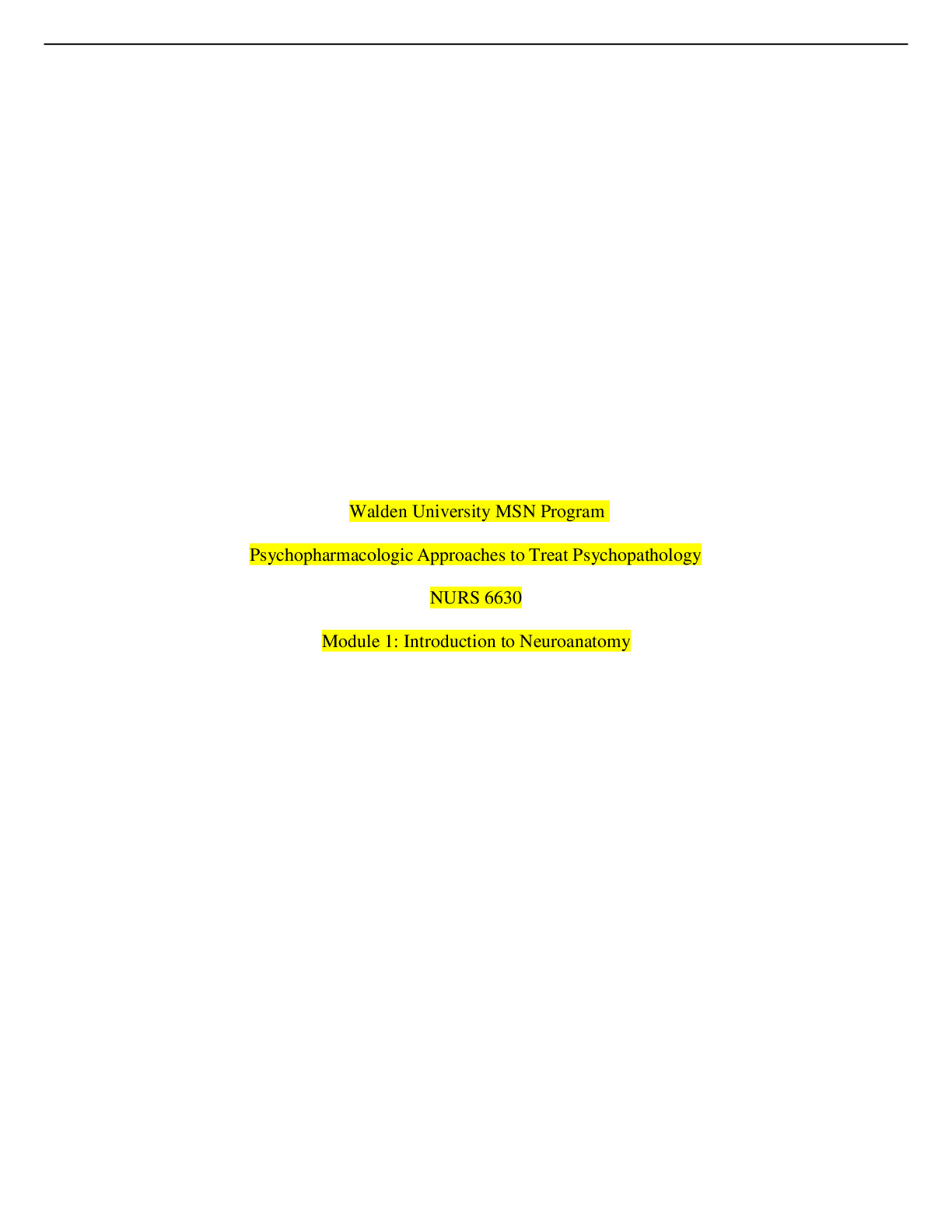





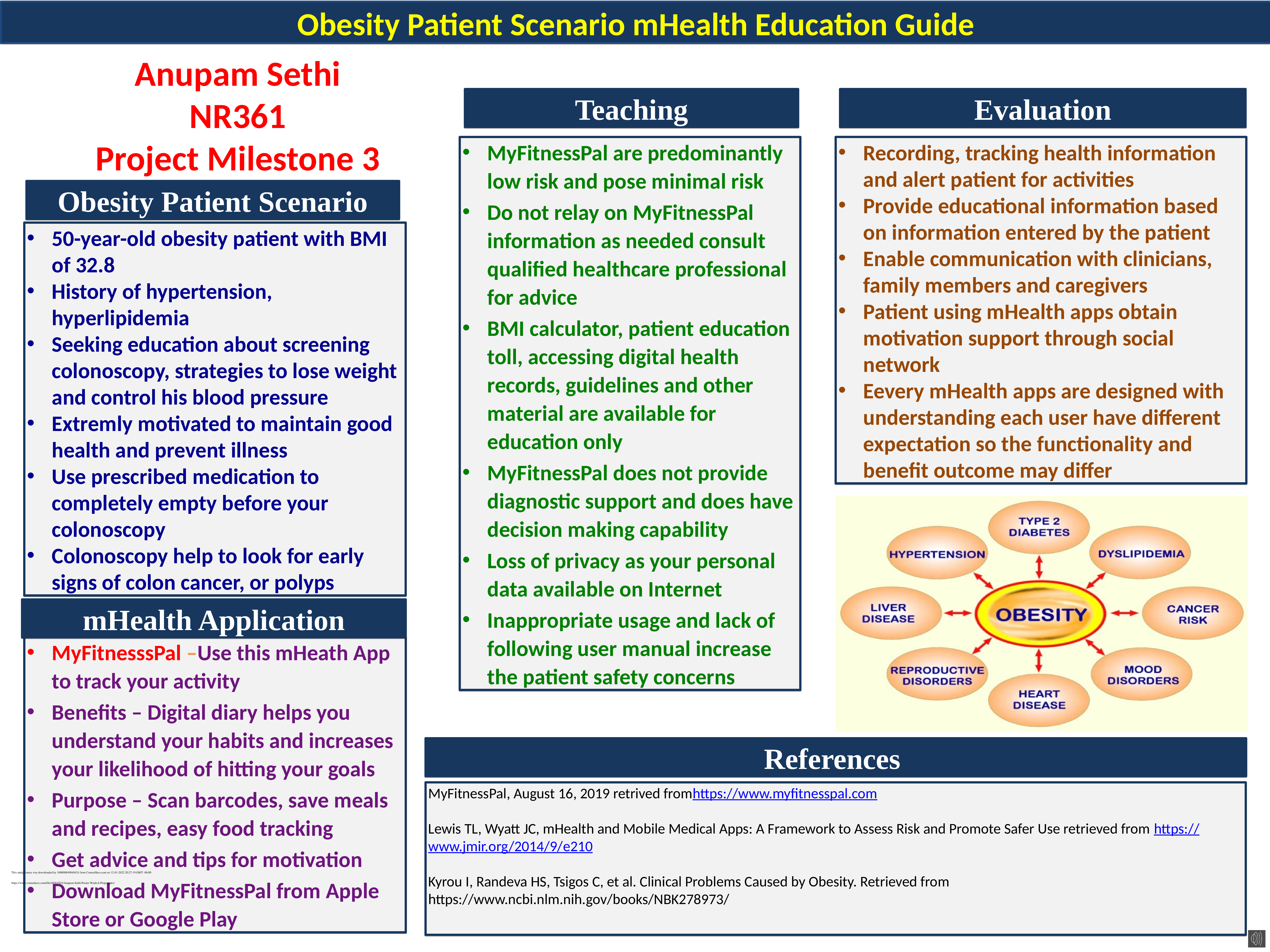



.png)
